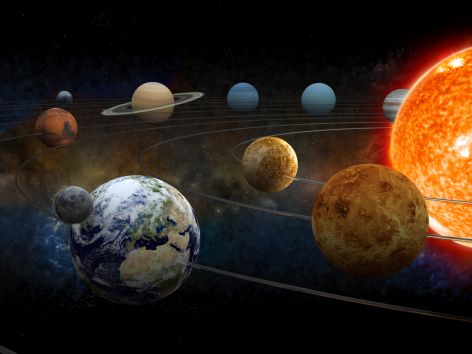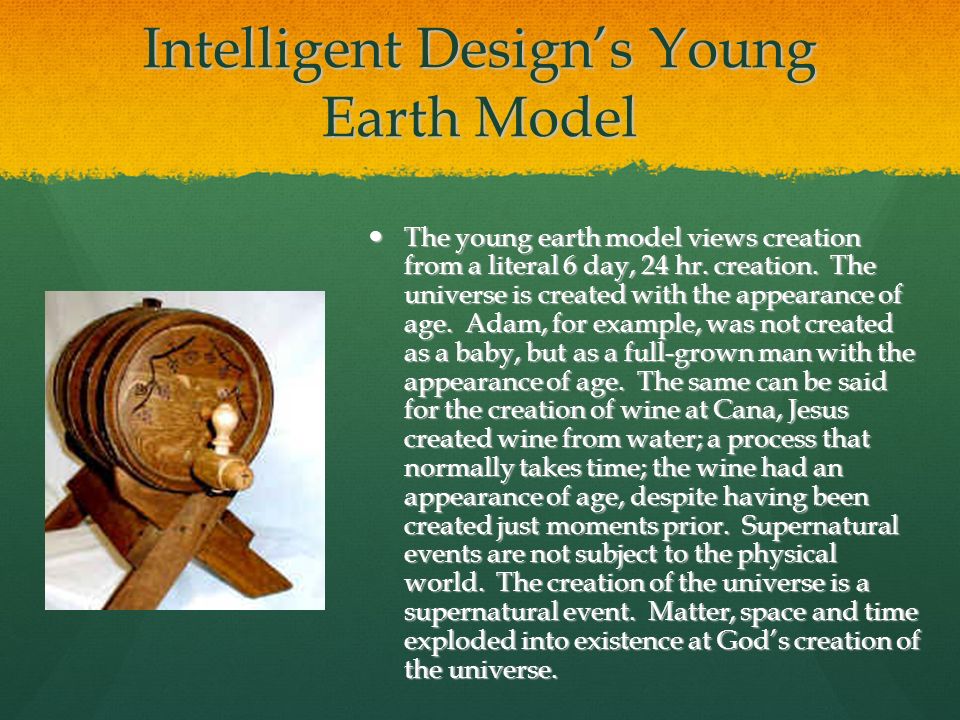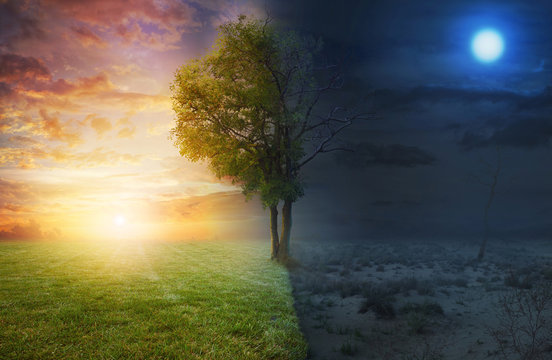

Assumptions and Premises
The conclusions drawn from the evidence depend on the assumptions and premises used to interpret that evidence.
If one starts with the premise of a young Earth (6,000 years old), the same evidence would be interpreted differently, and would be seen as supporting a young Earth.
The earth is believed to be 4.5 billion years old. This is an assumption, not a scientific fact. It’s the premises that modern scientists start with to evaluate the evidence. If they have got the premises wrong, then they will draw false conclusions from the evidence. Therefore, Old Earth theology is based on a belief system, not scientific facts.
That’s the nature of scientific enquiry: our understanding is influenced by our starting assumptions and world-view. It’s important to acknowledge and consider alternative perspectives.
In creation science, the same data is often reinterpreted through the lens of a young Earth and a global flood. While this approach differs from mainstream science, it’s important to engage in respectful dialogue and understand the different perspectives.
Let’s keep exploring and discussing these ideas!
Introduction
The origin and age of the Earth have long been topics of scientific debate. While the prevailing view holds that the Earth is approximately 4.5 billion years old, emerging evidence and reevaluations of existing data suggest that a young Earth, created by an intelligent designer, could be a viable scientific possibility.
Geological Evidence
- Rapid sedimentation and fossilisation, consistent with a global flood
- Lack of erosion between geological layers, indicating rapid deposition
- Presence of soft tissue and original biomolecules in dinosaur fossils
Cosmological Evidence
- The Earth’s magnetic field, decaying at a rate inconsistent with an old Earth
- The presence of comets and asteroids, suggesting a young solar system
- The universe’s fine-tuning, hinting at intelligent design
Biological Evidence
- The complexity and irreducible complexity of biological systems
- The rapid diversification of life forms, consistent with a recent creation
- The presence of vestigial structures, indicating design rather than evolution
Conclusion
While this article presents a case for a young Earth and intelligent design, it is essential to acknowledge the ongoing scientific dialogue. Further research and evidence will continue to refine our understanding of the Earth’s origins. By considering alternative perspectives and engaging in respectful discussion, we may uncover new insights into the mysteries of our planet’s creation.
Therefore, it is impossible to scientifically prove whether the earth is young or old. Because either way you have to start with an unscientific premise based on your world-view, which is an assumption, not scientific facts.
In my view, it’s better to believe God than man, because He was there at the beginning. Genesis 1:1. In the beginning God created the heavens and the earth.
Unpacking the Meaning of “Day” in Genesis 1

A Closer Look at the Hebrew Text
Introduction
The book of Genesis, specifically chapter 1, has been the subject of much debate and interpretation.
One of the key points of discussion centres around the meaning of the Hebrew word “yom,” translated as “day” in English.
While some interpret “yom” as a period of time or an era, a closer examination of the Hebrew text reveals that it indeed refers to a literal 24-hour day.
The Hebrew Word “Yom”
- In Hebrew, “yom” is the word used to describe a standard 24-hour day. It is used throughout the Old Testament to denote a daily cycle, and its meaning is unequivocal in most contexts.
- In Genesis 1, “yom” is used to describe the six days of creation, with God resting on the seventh “yom.”
Linguistic Evidence
- The Hebrew word “yom” is always used to describe a literal day in other Old Testament passages. –
- The context of Genesis 1, with its repetitive structure and numerical sequence (Day 1, Day 2, etc.), indicates a consistent and literal meaning. –
- The Hebrew language lacks a specific word for “period” or “era,” making “yom” the most appropriate choice for a 24-hour day.
Biblical Context
The creation account in Genesis 1 is presented in a sequential and chronological manner, suggesting literal days. – The Sabbath commandment in Exodus 20:11, “For in six days the Lord made heaven and earth, the sea, and all that is in them, and rested the seventh day,” reinforces the literal interpretation of “yom” in Genesis 1.
Conclusion
In conclusion, a thorough examination of the Hebrew text and linguistic evidence demonstrates that the word “yom” in Genesis 1 indeed refers to a literal 24-hour day. This understanding not only aligns with the biblical context but also underscores the significance of God’s creative work within a specific time-frame. By acknowledging the literal meaning of “yom,” we can deepen our appreciation for the intricacies of Scripture and the majesty of God’s creation.
Genesis 1
In the beginning God created the heavens and the earth. [2] And the earth was a formless and desolate emptiness, and darkness was over the surface of the deep, and the Spirit of God was hovering over the surface of the waters. [3] Then God said, “Let there be light”; and there was light. [4] God saw that the light was good; and God separated the light from the darkness. [5] God called the light “day,” and the darkness He called “night.” And there was evening and there was morning, one day. [6] Then God said, “Let there be an expanse in the midst of the waters, and let it separate the waters from the waters.” [7] God made the expanse, and separated the waters that were below the expanse from the waters that were above the expanse; and it was so. [8] God called the expanse “heaven.” And there was evening and there was morning, a second day. [9] Then God said, “Let the waters below the heavens be gathered into one place, and let the dry land appear”; and it was so. [10] And God called the dry land “earth,” and the gathering of the waters He called “seas”; and God saw that it was good. [11] Then God said, “Let the earth sprout vegetation, plants yielding seed, and fruit trees on the earth bearing fruit according to their kind with seed in them”; and it was so. [12] The earth produced vegetation, plants yielding seed according to their kind, and trees bearing fruit with seed in them, according to their kind; and God saw that it was good. [13] And there was evening and there was morning, a third day. [14] Then God said, “Let there be lights in the expanse of the heavens to separate the day from the night, and they shall serve as signs and for seasons, and for days and years; [15] and they shall serve as lights in the expanse of the heavens to give light on the earth”; and it was so. [16] God made the two great lights, the greater light to govern the day, and the lesser light to govern the night; He made the stars also. [17] God placed them in the expanse of the heavens to give light on the earth, [18] and to govern the day and the night, and to separate the light from the darkness; and God saw that it was good. [19] And there was evening and there was morning, a fourth day. [20] Then God said, “Let the waters teem with swarms of living creatures, and let birds fly above the earth in the open expanse of the heavens.” [21] And God created the great sea creatures and every living creature that moves, with which the waters swarmed, according to their kind, and every winged bird according to its kind; and God saw that it was good. [22] God blessed them, saying, “Be fruitful and multiply, and fill the waters in the seas, and let birds multiply on the earth.” [23] And there was evening and there was morning, a fifth day. [24] Then God said, “Let the earth produce living creatures according to their kind: livestock and crawling things and animals of the earth according to their kind”; and it was so. [25] God made the animals of the earth according to their kind, and the livestock according to their kind, and everything that crawls on the ground according to its kind; and God saw that it was good. [26] Then God said, “Let Us make mankind in Our image, according to Our likeness; and let them rule over the fish of the sea and over the birds of the sky and over the livestock and over all the earth, and over every crawling thing that crawls on the earth.” [27] So God created man in His own image, in the image of God He created him; male and female He created them. [28] God blessed them; and God said to them, “Be fruitful and multiply, and fill the earth, and subdue it; and rule over the fish of the sea and over the birds of the sky and over every living thing that moves on the earth.” [29] Then God said, “Behold, I have given you every plant yielding seed that is on the surface of all the earth, and every tree which has fruit yielding seed; it shall be food for you; [30] and to every animal of the earth and to every bird of the sky and to everything that moves on the earth which has life, I have given every green plant for food”; and it was so. [31] And God saw all that He had made, and behold, it was very good. And there was evening and there was morning, the sixth day.
1:1-31 The simple statement that God created the heavens and the earth is one of the most challenging concepts confronting the modern mind. The vast galaxy we live in is spinning at the incredible speed of about 490,000 miles an hour. But even at this breakneck speed, our galaxy still needs over 200 million years to make one rotation. And there are at least one trillion other galaxies in the universe.
It has been said that the number of stars in the universe is more than all the grains of sand on all the beaches of the world. Yet this complex sea of spinning stars functions with remarkable order and efficiency. To say that the universe “just happened” or “evolved” requires more faith than to believe that God is behind these amazing statistics. God truly did create a wonderful universe, and he is worthy of our praise.
God did not need to create the universe; he chose to create it. Why? God is love, and love is best expressed toward something or someone else—so God created the world and people as an expression of his love. We should avoid reducing God’s creation to merely scientific terms. Remember that God created the universe because he loves us.
